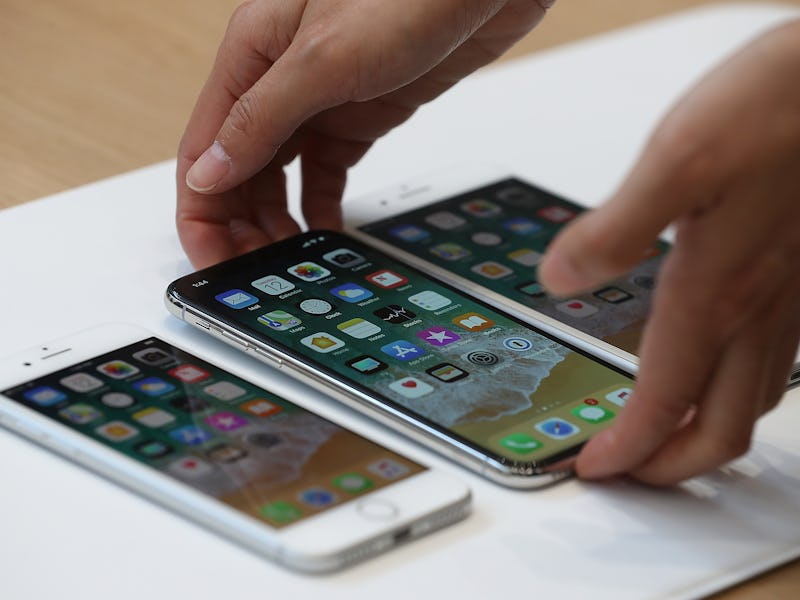The 6 Subtle Differences Between iPhone 8 Plus and iPhone X
There's some big changes lurking under the hood.

The iPhone X is going to be expensive. When it launches on November 3, the $999 phone will have by far the biggest starting price tag of any iPhone ever produced. It makes the $799 iPhone 8 Plus, which launched this month, seem far more reasonable.
The differences between the two phones may appear subtle, but there are a few reasons why you may want to take the plunge on Apple’s high-end device. In particular, pixel peepers and camera coveters may want to go for the more expensive model when pre-orders start on Friday. Here’s what you need to know.
See also: Here’s What You Get When You Buy the iPhone X
Battery
The 8 Plus uses a 2,691 mAh capacity battery, while the X uses a 2,716 mAh pack. That means the X has more capacity, but it doesn’t necessarily play out that way. Apple is coyly describing the X as having two hours’ more life than the iPhone 7, which could mean that the added features on the X use enough life to reduce the difference with the 8 Plus — but then, it’s those features that may make the iPhone X the preferred pick. Hands-on reviews will show how the respective batteries run in practice.
Camera
On paper, the rear camera appears almost identical to the 8 Plus, but there are a couple subtle differences to be aware of. First, and probably the most obvious, is the lenses are set in a vertical arrangement rather than horizontal.
The less visible change, and the one that might actually affect your photos, is that both lenses on the iPhone X have optical image stabilization. On the 8 Plus, it’s just the wide angle lens with this feature.
The new iPhone X is displayed during an Apple special event at the Steve Jobs Theatre on the Apple Park campus on September 12, 2017 in Cupertino, California.
This means that, when taking a photo in dim light, the lens can adjust to counteract the movement of your hands. This will cut back on light streaks that normally occur in these situations. On the X, you’ll be able to take advantage of this benefit even when snapping subjects further away.
The telephoto lens also gains a boost in aperture, moving from f/2.8 to f/2.4. This means shallower depth-of-field and more light hitting the sensor.
Screen
Where the 8 Plus has a 5.5-inch screen, the X boosts this to 5.8 inches. That’s because the screen extends all the way to the top and bottom, meaning more room for content.
It also packs more pixels. Where the 8 Plus has a display that 1,920 by 1,080 pixels at 401 pixels per inch, the X offers 2,436 by 1,125 pixels at 458 ppi.
The more expensive device also plays back high dynamic range content in its full glory, whether it’s from the Dolby Vision or HDR10 standards. Compatible movies will shine through on the device, providing a far greater range of colors.
The X also switches out the LCD screen in favor of an OLED-based one. This means it’s capable of displaying far deeper blacks, meaning objects on a black background will appear to float in the middle of the device. Where the 8 Plus has a contrast ratio of 1,300 to one, the X has a ratio of a million to one. It’s pretty nifty, and it helps explain why Apple opted to call it the “Super Retina Display.”
See also: iPhone X Launch ‘Catastrophe’ Will Drag On Longer Than You Think
Face ID
Possibly the most talked-about feature is the facial recognition system, which replaces both the home button and fingerprint sensor with a hands-free scanner that works much like Microsoft’s Xbox Kinect. Point your phone at the screen, and in a matter of milliseconds it unlocks thanks to a complex depth-scanning system.
Face ID also enables interactive Animoji in iMessage, enabling fun new ways to create images to send to friends.
Apple's senior vice president of Software Engineering Craig Federighi speaks during an Apple special event at the Steve Jobs Theatre on the Apple Park campus on September 12, 2017 in Cupertino, California.
Portrait Mode
You’re probably aware the iPhone 8 Plus offers a Portrait Mode with Portrait Lighting effects. These two features use the two cameras on the rear to identify how far away the subject of an image is, blurring the background and providing a number of lighting effects normally reserved for high-end studio setups.
What you may not know is the iPhone X also offers those same features on the front-facing camera. The phone uses the same depth-sensing technology to bring these features to the other camera, despite the fact there’s only one camera on the front. If you’re looking for the very best selfies, the iPhone X will likely deliver.
Size
It probably goes without saying, but the X is smaller. It’s 5.65 x 2.79 inches with a thickness or 0.3 inches, compared to the 8 Plus that’s 6.24 x 3.07 inches with the same thickness. Weight-wise, the X is just 6.14 ounces where the 8 Plus is 7.13 ounces.
For more on the iPhone 8, iPhone 8 Plus, and iPhone X, check out previous coverage, including: